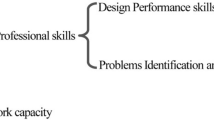Abstract
The article investigates the relationship between admission exam and students’ performance on an interior design program. To achieve the objective of the study, a survey was conducted of 50 students from an interior design program. The performance of these 50 students was tracked from year 1 to year 4 of their degree program. Paired samples testing and linear regression analysis were performed. Then, the study randomly evaluated the admission criteria of 33 Council for Interior Design (USA) accredited programs (in 4 countries: USA, Canada, United Arab Emirates, and Qatar. The study reveals that there is no significant relationship between admission exam (skill exam) and students’ performance. There is also a significant difference in performance in an admission exam and the performance for students who hold a scholarship and for local compared with international students. The regression analysis, demonstrated that holding a scholarship and nationality are associated with performance in an admission exam. The critical evaluation of 33 Council for Interior Design (USA) accredited programs showed that a variety of different admission criteria were used (e.g. skill exam, portfolio, and high school/college GPA). In particular, 61% of the sample universities included submission of a design portfolio (USA: 37%; Canada: 92%; United Arab Emirates: 100%; Qatar: 100%) as part of the requirements for admission. The study also suggested that the Council for Interior Design (USA) should provide general guidelines on admission criteria for undergraduate interior design programs. Policy implications are also offered.





Similar content being viewed by others
References
Abbott, A. (1988). The system of professions: An essay on the division of expert labor. Chicago: University of Chicago Press.
Alkhalidi, A. S. (2015). Future directions in interior design education. Journal of Leadership and International Development (1), ICIRS Conferences, pp. 1–11 conference proceedings of the 10th annual education and development conference, Bangkok. http://www.scholarpractitionerjournals.com/article/future-directions-interior-design-education. Accessed 1 Dec 2017.
Badley, G. (2003). The crisis in educational research: A pragmatic approach. European Educational Research Journal, 2(2), 295–308.
Bontekoe, J. F. (1992). The ACT as a predictor of college success at Trinity Christian College. Palos Heights, IL: Trinity Christian College.
Brunner, L. A. (2009). Undergraduate interior design program admissions: What is the best predictor of future “success?” In Art and design conference proceedings, presentations and posters (Vol. 4). http://lib.dr.iastate.edu/ad_conf/4. Accessed 4 February 2018.
Bryman, A. (2006). Integrating quantitative and qualitative research: How is it done? Qualitative Research, 6(1), 97.
Field, A. P. (2009). Discovering statistics using SPSS. London: Sage.
Findeli, A. (2001). Rethinking design education for the 21st century: Theoretical, methodological, and ethical discussion. Design Issues, 17(1), 5–17.
Guerin, D., & Thompson, J. A. (2004). Interior design education in the 21st century. Journal of Interior Design, 30(1), 1–12.
Hammersley, M. (2002). Educational research, policymaking and practice. London: Paul Chapman.
Husen, T. (1988). Research paradigms in education. Interchange, 19(1), 2–13.
Johnson, R. B., & Onwuegbuzie, A. J. (2004). Mixed methods research: A research paradigm whose time has come. Educational Researcher, 33(7), 14–26.
Klitgaard, R. E. (1985). Choosing elites. New York: Basic Books Inc.
Kolar, J., & Gorman, M. A. (1987). Determining the significance of standardized tests administered to entering interior design majors. Journal of Interior Design, 13(1), 45–50.
Koretz, D., Yu, C., Mbekeani, P., Langi, M., Dhaliwal, T., & Braslow, D. (2016). Predicting freshman grade point average from college admissions test scores and state high school test scores. AERA Open, 2(4), 1–13.
Martin, C. (1998). Professionalization: Architecture, interior decoration, and interior design as defined by Abbott. Master’s thesis, Department of design, University of Minnesota.
Montgomery, D. C., Peck, E. A., & Vining, G. G. (2001). Introduction to linear regression analysis. New York: Wiley.
Peggram, R. E. (2007). Personality traits in predicting interior design students' academic success and persistence. Doctoral dissertation, Texas Tech University.
Reagans, R., & McEvily, B. (2003). Network structure and knowledge transfer the effects of cohesion and range. Administrative Science Quarterly, 48, 240–267.
Rigol, G. W. (2003). Admissions decision-making models: How US institutions of higher education select undergraduate students. New York: College Entrance Examination Board.
The World Bank. (2008). University admission worldwide. Washington, DC: International Bank for Reconstruction and Development/The World Bank.
Varaki, B. S., Floden, R. E., & Kalatehjafarabadi, T. J. (2015). Para quantitative methodology: Reclaiming experimentalism in educational research. Open Review of Educational Research, 2(1), 26–41.
Wambugu, L. & Emeke, A. (2013). Relationship between entry qualification and academic performance in undergraduate science courses at the University of Nairobi, Kenya. http://oasis.col.org/handle/11599/1807. Accessed 24 March 2018.
Acknowledgements
The authors gratefully acknowledge the support of Thekra A. Al-Mubaddel, Interior Design Engineering Department, College of Engineering, Prince Sultan University, in data collection.
Author information
Authors and Affiliations
Corresponding author
Appendix
Rights and permissions
About this article
Cite this article
Aburas, R., Nurunnabi, M. The relationship between admission exam and students’ performance on an undergraduate interior design program. Int J Technol Des Educ 29, 961–986 (2019). https://doi.org/10.1007/s10798-018-9474-z
Accepted:
Published:
Issue Date:
DOI: https://doi.org/10.1007/s10798-018-9474-z




